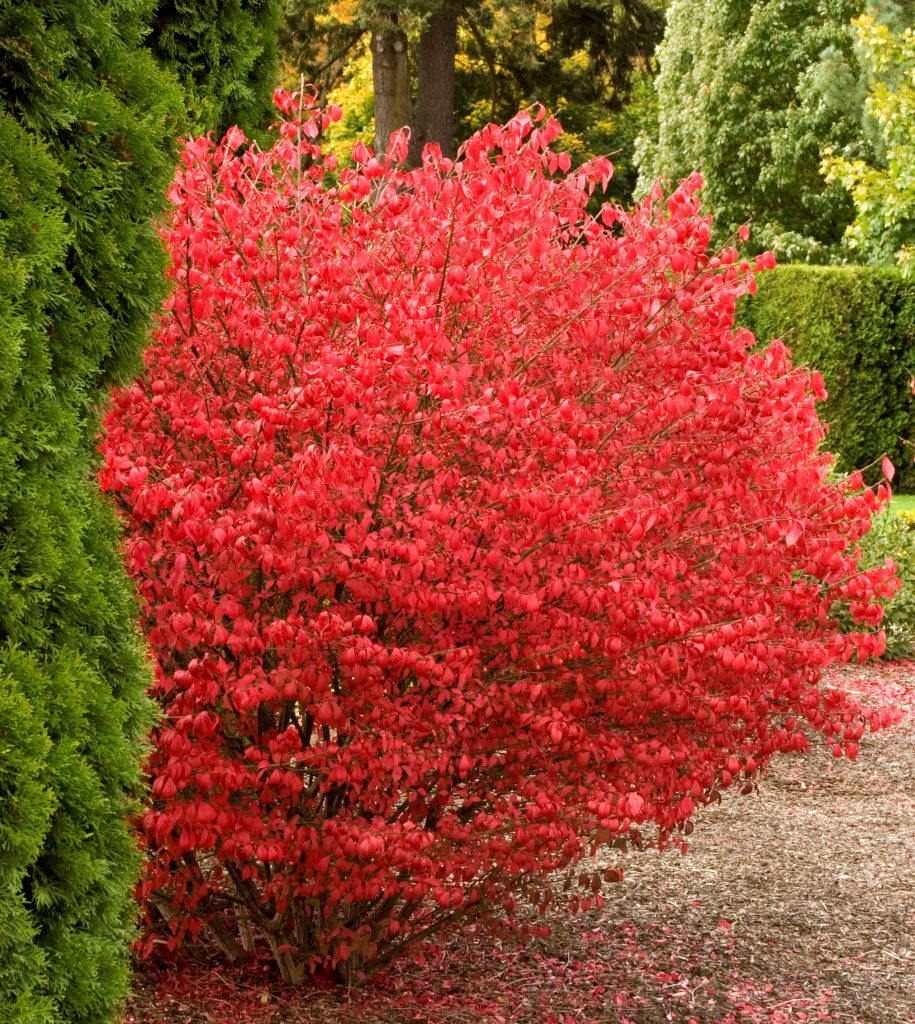by Ken Lain, the mountain gardener

Burning bush, Euonymus alatus, is a neat, well-behaved shrub prized for its blazing red foliage in Fall. Looks great when planted with autumn gold natives like sumac, lilac, and gold euonymus. Growing to head height, this bush makes a natural hedge that burns red through Autumn. Sensational as a wild garden accent where more interest and color is needed.
A deciduous shrub is native to Asia that has become popular for North American landscapes. The dense, multi-stemmed shrub received its common name from the burning red fall foliage. The shrub is best planted in the Fall or spring and grows a foot per year. Tiny golden flowers show in late spring, providing pollen for butterflies and foraging bees. Pretty red to orange berries show off in Autumn that extends this shrubs decorative value.
Botanical Name Euonymus alatus
Common name Burning bush, winged spindle, winged euonymus.
Plant Type Deciduous shrub
Mature Size 10′ feet tall x 6′ feet wide
Sun Exposure 6+ hours of sun
Soil Type Average, moderately moist
Soil pH 6-8 pH
Bloom Time Spring
Flower Color Gold
Hardiness Zones 4 to 8
Native Area China, Japan, Korea, eastern Russia
How to Grow Burning Bush Plants
Burning bush is a hardy, adaptable shrub that tolerates mountain soil. A burning bush is a beautiful ornamental feature in a landscape, especially with its autumn red foliage. Many gardeners plant them alone as accents. They can also be grouped to form a hedge or screen.
Light
In the mountains, this Maple prefers 6+ hours of sun. The more sun equals more leaves with better Autumn color.
Soil
This Maple prefers well-drained soil. Test the planting hole by filling it with water in the morning. If water is still pooling in the dug hole at the end of the day, you have drainage issues that will need more work.
Water newly planted trees regularly with a garden hose for at least one month (2 months in Summer). Automatic irrigation systems may not be sufficient initially. Water frequency will vary according to season, exposure and plant size.
April – Oct this Maple should be irrigated 2 x weekly
Nov – Mar this Maple should be irrigated 2 x monthly
Feed 4x Times per Year with either 7-4-4 All Purpose Plant Food, Soil Sulfur, or Humic. Here’s the recommendation by season:
Spring = 7-4-4 All Purpose Food + Soil Sulfur
Summer = 7-4-4 All Purpose Food + Humic
September = 7-4-4 All Purpose Food
December = 7-4-4 All Purpose Food
Various cultivars of burning bush exist, ranging in size and appearance.
Rudy Haag – matures to 3-5′ feet tall
Pipsqueak – is compact as well at 5′ feet tall.
Compactus – is less compact, sometimes reaching 8′ feet tall.
Apterus – has smooth stems, rather than the distinctive ridges that appear on most varieties, and reaches around 6′ feet tall.
Monstrosus – has very pronounced ridges and can mature at 15′ feet tall.
Toxicity of Burning Bush
The toxic components found in all parts of the burning bush affect humans, dogs, cats, and horses. However, wild birds and rodents eat the berries from this plant without problems. It’s not common for people or animals to eat enough of the plant to result in a fatal dose, as the taste is extremely bitter. But the toxins can cause severe symptoms, especially in small children and animals.
The most common result from eating part of a burning bush is a strong laxative effect due to the alkaloids, organic compounds that can impact the body’s metabolic processes.
Burning bush is harmful only when ingested. Never worry about stems touching your skin or other body parts when pruning. This plant does not have poison ivy kind of symptoms.

